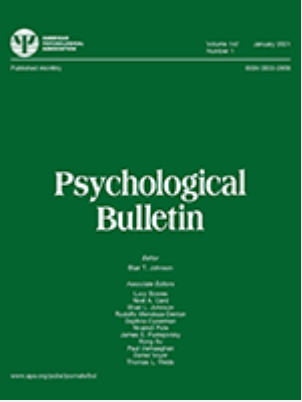Handedness in mental and neurodevelopmental disorders: A systematic review and second-order meta-analysis.
IF 19.8
1区 心理学
Q1 PSYCHOLOGY
引用次数: 0
Abstract
Several meta-analyses on hand preference in mental and neurodevelopmental disorders have been published in the last decade. Some disorders, like schizophrenia, have been associated with increased rates of atypical hand preference (i.e., non-right-, left-, or mixed-hand preference)-but others, like depression, have not. To identify overarching patterns between hand preference and psychopathology and estimate the influence of potential moderators independent of diagnosis, we need to leverage rich information in the databases of these meta-analyses and conduct a higher level of analysis of meta-analytic data across diagnoses. To this end, we performed a second-order meta-analysis after reviewing, updating, and reanalyzing previously published meta-analyses on hand preference in various mental and neurodevelopmental disorders. In total, this study includes 402 data sets totaling 202,434 individuals. On average, atypical hand preference had a significantly higher frequency in cases compared to controls (nonright odds ratio [OR]: 1.46, 95% CI [1.35, 1.59]; left OR: 1.34, 95% CI [1.22, 1.48]; mixed OR: 1.63, 95% CI [1.38, 1.93]). Further analyses indicated that case-control differences varied with diagnosis. Some diagnoses, like schizophrenia, are associated with a high frequency of atypical hand preference (nonright OR: 1.50, 95% CI [1.32, 1.70]; left OR: 1.37, 95% CI [1.17, 1.61]; mixed OR: 1.70, 95% CI [1.19, 2.44]). Moderator analyses showed that neurodevelopmental conditions, nonneurodevelopmental conditions with an early age of onset, and conditions that include symptoms related to language were all associated with higher rates of atypical hand preference. This finding suggests that the association between handedness and clinical conditions is best understood from a transdiagnostic, developmental, and symptom-focused perspective. (PsycInfo Database Record (c) 2025 APA, all rights reserved).精神和神经发育障碍中的偏手性:一项系统综述和二级荟萃分析。
在过去的十年里,已经发表了一些关于精神和神经发育障碍中手部偏好的荟萃分析。一些疾病,如精神分裂症,与非典型用手偏好(即非右手、左手或混合用手偏好)的比例增加有关,但其他疾病,如抑郁症,则没有关系。为了确定手偏好和精神病理学之间的总体模式,并估计独立于诊断的潜在调节因子的影响,我们需要利用这些荟萃分析数据库中的丰富信息,并对跨诊断的荟萃分析数据进行更高水平的分析。为此,我们在回顾、更新和重新分析之前发表的关于各种精神和神经发育障碍的手部偏好的荟萃分析后,进行了二级荟萃分析。这项研究总共包括402个数据集,共计202,434人。平均而言,非典型手偏好在病例中出现的频率显著高于对照组(非右优势比[OR]: 1.46, 95% CI [1.35, 1.59];左OR: 1.34, 95% CI [1.22, 1.48];混合OR: 1.63, 95% CI[1.38, 1.93])。进一步分析表明,病例-对照差异因诊断而异。一些诊断,如精神分裂症,与非典型手偏好的高频率相关(非右OR: 1.50, 95% CI [1.32, 1.70];左OR: 1.37, 95% CI [1.17, 1.61];混合OR: 1.70, 95% CI[1.19, 2.44])。调节分析表明,神经发育状况、早期发病的非神经发育状况以及包括语言相关症状的状况都与非典型手偏好的较高发生率相关。这一发现表明,从跨诊断、发育和以症状为中心的角度来理解利手性与临床状况之间的关系是最好的。(PsycInfo Database Record (c) 2025 APA,版权所有)。
本文章由计算机程序翻译,如有差异,请以英文原文为准。
求助全文
约1分钟内获得全文
求助全文
来源期刊

Psychological bulletin
医学-心理学
CiteScore
33.60
自引率
0.90%
发文量
21
期刊介绍:
Psychological Bulletin publishes syntheses of research in scientific psychology. Research syntheses seek to summarize past research by drawing overall conclusions from many separate investigations that address related or identical hypotheses.
A research synthesis typically presents the authors' assessments:
-of the state of knowledge concerning the relations of interest;
-of critical assessments of the strengths and weaknesses in past research;
-of important issues that research has left unresolved, thereby directing future research so it can yield a maximum amount of new information.
 求助内容:
求助内容: 应助结果提醒方式:
应助结果提醒方式:


